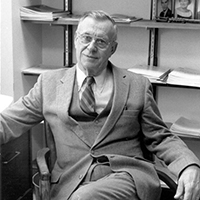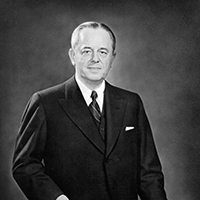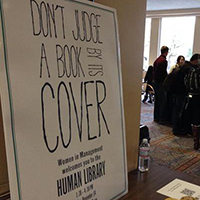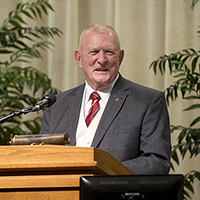Building for the Future
Late dean John Day recalls the origins of Purdue's first named school
The most vivid account of Purdue’s relationship with Herman Krannert comes from one of the School of Management’s founding members, the late John S. Day, who earned an MBA and PhD from Harvard University and was hired by inaugural dean Emanuel “Em” Weiler in 1956 to help launch the industrial management program. Day was named associate dean for faculty affairs in 1960 and succeeded Weiler as Krannert dean in 1969.
Excerpted from a series of interviews by Robert Topping, author of A Century and Beyond: The History of Purdue University, Day’s recollections are echoed in an oral history recorded by Katherine Markee in 2009 for the Virginia Kelly Karnes Archives and Special Collections Research Center in Purdue Libraries.
 We began our first relationships with Mr. Krannert in the fall of 1960. Mrs. Krannert owned one of the prize herds of cattle in this country and the herd had been struck with a disease. Mr. Krannert had appealed to Purdue’s animal science people for help. Under the direction of Fred Andrews, who at that time was head of the animal sciences department, they were successful in eradicating the disease. In casual conversation, Mr. Krannert said to Professor Andrews, “I’ve been so impressed with the work you people have done with our cattle. Do you have the same kind of experts at Purdue who could solve some of my business problems?” Andrews, bless his heart, said, “I know just the man you should talk to,” whereupon he called Dean Weiler.
We began our first relationships with Mr. Krannert in the fall of 1960. Mrs. Krannert owned one of the prize herds of cattle in this country and the herd had been struck with a disease. Mr. Krannert had appealed to Purdue’s animal science people for help. Under the direction of Fred Andrews, who at that time was head of the animal sciences department, they were successful in eradicating the disease. In casual conversation, Mr. Krannert said to Professor Andrews, “I’ve been so impressed with the work you people have done with our cattle. Do you have the same kind of experts at Purdue who could solve some of my business problems?” Andrews, bless his heart, said, “I know just the man you should talk to,” whereupon he called Dean Weiler.
Shortly thereafter, Ron Stuckey, several faculty members and I visited some of the Inland Container plants while Em worked directly with Mr. Krannert. We eventually developed a management program for the executives of the company, a program that was established on a rather unique basis. We divided the executives into two groups. Each group would come to campus for a three-day period every other month. This would last for approximately a year, after which there would be a full week of study to complete the program. The subjects were traditional: finance, marketing, policy and accounting. However, unlike many such programs that use “canned” material, we made a very conscious attempt to relate our teaching to the particular company and the industry. Faculty members actually went into the company and wrote cases about specific problems. For example, if we were studying about a marketing problem, we tried to look at it both from the company’s point of view as well as the industry’s. Though there were a few administrative problems common to any new endeavor of this sort, the consensus seemed to be that the program was most successful.
Though the Inland Container Corporation gave us a grant to underwrite the program, the real value to the school was the opportunity it provided for Dean Weiler to work closely with Mr. Krannert. They very quickly became good friends. It’s a real accolade to Em that Mr. Krannert began to place more and more confidence in him as an individual. Eventually, he asked Em to become a member of Inland’s board of directors and later made him a member of the executive committee, which, of course, actively involved Em in the current operations of the company.
As Em Weiler’s friendship with Mr. Krannert and his involvement in the Inland Container Corporation grew, it seemed clear there was a possibility that Mr. Krannert might make a sizable contribution to the University if we could overcome his fear that a donation from him would be a substitute for state funds. Em handled this sensitive area brilliantly. He made a very convincing argument to Mr. Krannert that though his tax money was underwriting the undergraduate program, there was great need for funds to support our graduate efforts.
Since 1956 when the Department of Management was first formed as a separate entity, all activity had been located in the rear wing of Stanley Coulter Annex. Five years found us with ever growing programs and severely cramped for space. Despite an obvious need for more offices and classrooms, we discovered we were low on the priority list for a new building supported with state funds.
Thus, Em and R.B. Stewart, vice president for business at Purdue, who had successfully negotiated earlier with Mr. Krannert for support of a facility in Indianapolis, approached Mr. Krannert with a proposal to fund a new home for the School of Industrial Management. Mr. Krannert, they knew, was the kind of donor who liked efficient use of his money. Consequently, the original proposal was for a relatively modest-sized new building that would be named after him. Mrs. Krannert was also very much interested in the project. As a strong supporter of the arts, she argued that all accepted designs contain a drawing room where art could be displayed and musicals held.
As the plans took shape, it became apparent that the expansion of the graduate programs in the School of Industrial Management, the development of extensive library facilities and the offering of special events would require far more financial means than could be obtained from the University budget. Eventually, the proposal called not only for support for the building, but also an endowment to underwrite graduate and special programs. In turn, the University would call the whole effort the Krannert Graduate School of Industrial Administration.







